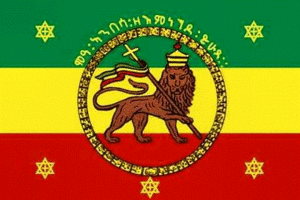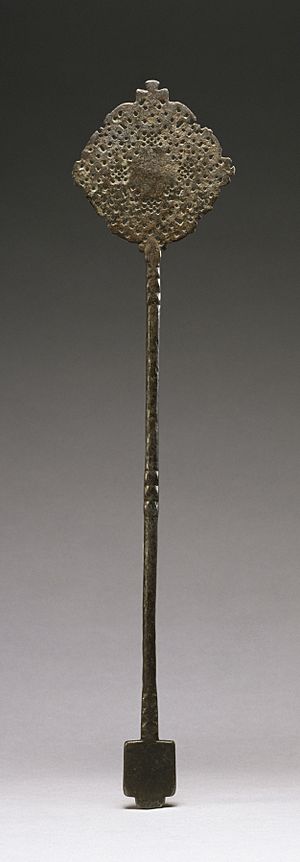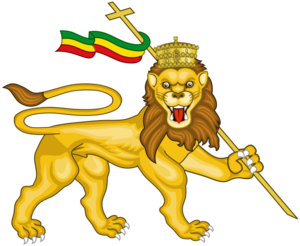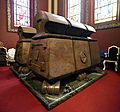Solomonic dynasty facts for kids
| House of Solomon |
|||
|---|---|---|---|
Quick facts for kids  |
|||
| Country: |
|
||
| Parent House: | House of David (claimed) | ||
| Titles: | *Emperor of Ethiopia
|
||
| Final Ruler: | Haile Selassie I | ||
| Current Head: | Zera Yacob Amha Selassie | ||
| Founding Year: | 900 B.C. | ||
| Cadet Branches: | Amhara Branch, Tigrayan Branch, Shewan Branch, Gojjam Branch, Yejju Branch, Gondar Branch, Wollo Branch, Selalle Branch | ||
The Solomonic dynasty, also known as the House of Solomon, was the ruling family of the Ethiopian Empire. Members of this family claimed to be direct descendants of the biblical King Solomon and the Queen of Sheba. According to tradition, the Queen of Sheba had a son, Menelik I, after visiting Solomon in Jerusalem.
In 1270, the Zagwe dynasty of Ethiopia was overthrown by Yekuno Amlak. He claimed to be a descendant of Solomon. This event restarted the Solomonic era in Ethiopia. The dynasty ruled until 1974, when a coup d'état (a sudden takeover of government) removed Emperor Haile Selassie from power.
History of the Solomonic Dynasty
The Solomonic dynasty was very important for Judaism and later for Ethiopian Orthodox Christianity in Ethiopia. Some people claim this dynasty ruled Ethiopia as early as 1000 BC. However, there is no strong historical proof for this early date.
Records of the dynasty were supposedly kept by Ethiopian Orthodox monasteries. But many of these records were lost. This happened when the Jewish Queen Judith I destroyed many Orthodox monasteries around 960 AD.
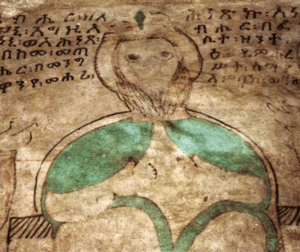
Yekuno Amlak, a prince from the old province of Bet Amhara, brought the dynasty back. He said he was related to the last Solomonic King of Axum, Dil Na'od. The dynasty was re-established on August 10, 1270 CE. This was when Yekuno Amlak overthrew the last ruler of the Zagwe dynasty.
Yekuno Amlak claimed to be a direct male descendant of the old Axumite royal family. This family had been replaced by the Zagwes. Menelik II and his daughter Zewditu I were the last Ethiopian rulers who could claim a direct male line from Solomon and the Queen of Sheba. Later emperors like Iyasu V and Haile Selassie I were related through female lines.
The Solomonic Dynasty ruled Ethiopia with only a few breaks until 1974. That year, the last emperor, Haile Selassie I, was removed from power. The royal family no longer rules the country. Many family members in Ethiopia were imprisoned after the 1974 revolution. Some were executed, and others went into exile.
In 1976, ten of Haile Selassie I's great-grandchildren were secretly taken out of Ethiopia. The women of the dynasty were released from prison in 1989. The men were released in 1990. Many members were allowed to leave the country in mid-1990. The rest left in 1991 when the communist government fell. Since then, many members of the Imperial family have returned to live in Ethiopia.
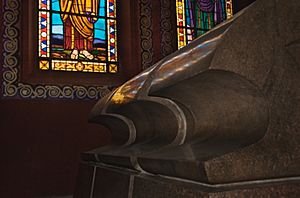
For much of its history, the dynasty mainly controlled the northwestern part of what is now Ethiopia. This area is known as the Ethiopian Highlands. The Empire grew and shrank over the centuries. Sometimes it included parts of modern-day Sudan and South Sudan. It also included coastal areas of the Red Sea and Gulf of Aden.
Southern and eastern regions became permanent parts of the empire in the last two centuries. Some were added by Shewan kings, and others by Emperors Menelik II and Haile Selassie I. However, some areas were lost after the invasion by Ahmad Gragn.
In more recent times, the Imperial dynasty had several different family branches. The older Gondarine line, which started with Susenyos in 1606, ended its rule in 1855. This was with the fall of the weak Emperor Yohannes III. Then Tewodros II came to power. His claims of being a Solomonic descendant were not widely accepted.
After Tewodros, Wagshum Gobeze claimed the throne. He was related to the last independent Gondare emperors through his mother. He ruled as Emperor Tekle Giorgis II for some years. He worked to restore churches and monuments in Gondar. He also had ties to the Zagwe throne, aiming to unite both dynasties. Tekle Giorgis II fought a battle with Kassai Mercha (who became Yohannes IV). Kassai Mercha had better weapons from the British. He defeated Tekle Giorgis II's army, imprisoned him, and killed him.
The Tigrean line briefly came to power when Yohannes IV became emperor in 1872. This line did not stay on the Imperial throne after Yohannes IV was killed in battle in 1889. However, the heirs of this branch continued to rule Tigre until the 1974 revolution.
The Shewan line was next on the Imperial throne. Menelik II, who was King of Shewa, became emperor in 1889. The Shewan Branch could trace its male line back to King Yekonu Amlak. The direct male line ended with Menelik II. He was followed by his daughter's son, Lij Iyasu (1913-1916). Then his daughter Zewditu ruled until 1930. Finally, Haile Selassie I became emperor. He was a son of a first cousin in the female line.
Haile Selassie's rule lasted until 1974, when the dynasty was removed from power. His grandson Prince Zera Yacob is considered his legal heir. He is the current head of the imperial family. The Shewan branch has several smaller branches.
The oldest junior branch of the Solomonic Dynasty is the Gojjam branch. This branch traces its family history through different lines of the main Solomonic dynasty. One important line comes from Princess Walata Israel. She was the daughter of Melmal Iyasu and Empress Mentewab. She married Dejazmach Yosedek. Their child, "Talaku" Ras Hailu, started the Gojam Imperial House.
The Princes of Gojam, like Ras Merid Hailu and Tekle Haymanot of Gojjam, all claim royal blood. They are connected to the main Gonder Imperial House through Empress Mentewab and the Solomonic Prince Melmal Iyasu. Recent members include Tekle Haimanot, King of Gojjam. His son, Leul Ras Hailu Tekle Haimanot, was a senior Ethiopian noble who accepted the Italian occupation from 1936–1941. His nephew, Ras Hailu Belew, was important in fighting against the Italian occupation.
Coat of Arms and Symbols
The Imperial Coat of Arms was adopted by Haile Selassie I. It is now held by his direct heir, Prince Zera Yacob, and by the Crown Council of Ethiopia. The coat of arms shows an Imperial Throne. Two angels stand next to it. One angel holds a sword and scales. The other holds the Imperial scepter.
The throne often has a Christian cross and a Star of David. These symbols represent the Christian and Jewish traditions. Above the throne is a red royal cloak with the Imperial Crown. In front of the throne is the Lion of the Tribe of Judah.
The Lion of Judah was the main symbol on the Ethiopian flag when the monarchy ruled. It is now the main symbol of the Ethiopian monarchist movement. The Lion of Judah is also a key religious symbol for the Rastafari movement. This movement, from the African diaspora, sees Emperor Haile Selassie as divine.
The phrase "Moa Ambassa ze imnegede Yehuda" was on the coat of arms. This means "Conquering Lion of the Tribe of Judah." This phrase always came before the Emperor's official titles. The official motto of the Imperial family was "Ityopia tabetsih edewiha habe Igziabiher." This means "Ethiopia stretches her hands unto God." It is a quote from the Psalm 68:31.
The full title of the Emperor of Ethiopia was Negusa Nagast and Seyoume Igziabeher. In Ge'ez, this means "Elect of God." The title Moa Anbessa Ze Imnegede Yehuda ("Conquering Lion of the Tribe of Judah") always came before the Emperor's titles. This was not a personal title. It referred to Jesus and showed that the Emperor submitted to Christ. Until the time of Yohannes IV, the Emperor was also Neguse Tsion, or "King of Zion." This title meant he ruled over much of the northern part of the Empire, with his seat in Axum.
Images for kids
-
Imperial sarcophagi of King Haile Selassie I and his wife at the Holy Trinity Cathedral
See also
 In Spanish: Dinastía salomónica para niños
In Spanish: Dinastía salomónica para niños


